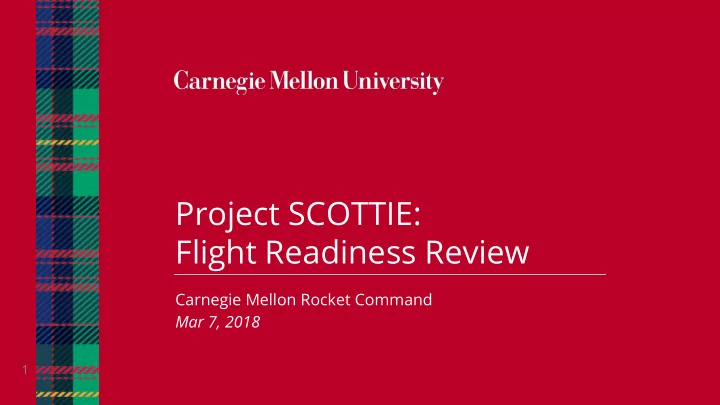

Project SCOTTIE: Flight Readiness Review Carnegie Mellon Rocket Command Mar 7, 2018 1
Table of Contents 1. Vehicle Overview ……………………………………………………………………………………………… 2. Apogee Targeting System ………………………………………………………………………………… 3. Recovery System ……………………………………………………………………………………………… 4. Mission Performance Predictions ……………............................................................... 5. Payload Overview ……………………………………............................................................... 6. Testing …………………………………………………………………………………………………………..… 7. Requirements Compliance Plan ………………............................................................... 8. Logistics …………………………………………………………………………………………………….…….. 2
Table of Contents 1. Vehicle Overview …………………………………………………………………………………… 2. Apogee Targeting System ………………………………………………………………………………… 3. Recovery System ……………………………………………………………………………………………… 4. Mission Performance Predictions ……………............................................................... 5. Payload Overview ……………………………………............................................................... 6. Testing …………………………………………………………………………………………………………..… 7. Requirements Compliance Plan ………………............................................................... 8. Logistics …………………………………………………………………………………………………….…….. 3
Vehicle Overview Motor Cap, Base, and Plate UAV Nosecone UAV Electronics 3 Tapered GPS Shoulder Sub-Compartment Fins Main Drogue Chute Chute 75 mm Ballast Recovery ATS Bay UAV Bay Motor Container Bay Tube 3:1 Ogive Nosecone Upper Lower Middle Nosecone Airframe Airframe Airframe Airframe =Switchbands 4
Summary of Vehicle Specifications Vehicle Section Dimensions Mass (lb) Ogive Nosecone 18” Length x 6.17” Base Di. X 1.47 4” Shoulder Nosecone Airframe 8” L x 6.17” OD 0.99 Upper Airframe 27” L x 6.17” OD 6.38 Middle Airframe 19” L x 6.17” OD 4.53 Lower Airframe 30” L x 6.17” OD 5.23 UAV Bay 14” L x 6” OD 6.94 Recovery Bay 10” L x 6” OD 3.7 ATS Bay 10” L x 6” OD 4.67 Fins [Next Section] 2.64 Motor Retention [Next Section] 4.38 Switchbands (x3) 2” L x 6.17” OD 0.25 Total 6.17” D x 109” L 38.3 (Dry), 48.3 (Wet) *All airframe/couplers are G12, and bulkheads/fins are G10 fiberglass. 5
Nose Cone Design 3:1 Tangent Ogive • Fiberglass reinforced • plastic mold 4” shoulder • 3 PEM nuts to • nosecone airframe 6
Fin Design 3 Trapezoidal Fins • 3/16” G10 Fiberglass • Epoxied to MMT and • filet with epoxy clay Fin flutter calcs: • ▪ Flutter Velocity- 2909 ft/s ▪ Max rocket velocity- 650 ft/s 7
Motor Retention System Thrust Plate In-house CNC’d from Al 6061 • Screws into aft centering ring • 75mm Flanged Retainer Purchased from Apogee Components • 8
Table of Contents 1. Vehicle Overview ……………………………………………………………………………………………… 2. Apogee Targeting System ………………………………………………………………………… 3. Recovery System ……………………………………………………………………………………………… 4. Mission Performance Predictions ……………............................................................... 5. Payload Overview ……………………………………............................................................... 6. Testing …………………………………………………………………………………………………………..… 7. Requirements Compliance Plan ………………............................................................... 8. Logistics …………………………………………………………………………………………………….…….. 9
ATS Overview Active prediction and control • system predicts apogee and enacts the appropriate control Electronically controlled drag • inducing flaps respond by extending and retracting to control speed 10
Flap Deployment System Features central hub • controlling flap extension through rotation Couples to • electronics bay using threaded rods and servo connection 11
Air Brake Flap Performance Flap CD evaluated at • key positions to provide prediction model a precise measurement of CD at different flap positions Rectangular flap design • produces a predictable, interpolable CD curve 12
Electronics Bay Sensor system 4x MPL3115A2 • altimeters BNO055 IMU • Computational system Raspberry Pi 3 • Deployment system SB2282SG servo • 13
Flap Deployment System and Electronics Bay Connection 14
Apogee Prediction Model Design Given a state X t including an altitude h t , vertical velocity s t and attitude h t 1. While ( s t > 0) Set X t to the prediction of X t+dt 2. Take h t to be the vehicle’s apogee. Repeatedly predicting vehicle state one time step into the future using • known launch vehicle physics and flap position based drag model Once vertical speed has reached 0, we take the current altitude to be • apogee 15
Controller Design The controller response U t corresponds to the distance of extension of the air brakes. • p and i correspond to the coefficients to the proportional and integral terms of error, • respectively. The function e(t) is the current difference between predicted apogee and desired • apogee. 16
ATS Testing Procedures Component Test Success Criteria Software Speed testing to ensure apogee prediction Prediction of apogee can be made in less cycle can occur within receipt of new than 0.51 seconds sensor data Sensor Integration Data transmission testing to ensure that ATS code on Raspberry Pi 3 successfully prediction and control system receives receives accurate data from each sensor timely and accurate information Electrical Speed testing to ensure that flaps can Full extension and Retraction of flaps can extend and retract within receipt of new occur within 0.51 seconds sensor data Mechanical Stress testing to ensure that flaps can Flaps can extend and retract while under withstand maximum expected load during a load of 29 lbs. flight Total System Full performance test of ATS during Apogee Targeting System allows test launch of SCOTTIE SCOTTIE to reach an altitude of 5100 +- 17 feet 17
Table of Contents 1. Vehicle Overview ……………………………………………………………………………………………… 2. Apogee Targeting System ………………………………………………………………………………… 3. Recovery System …………………………………………………………………………………… 4. Mission Performance Predictions ……………............................................................... 5. Payload Overview ……………………………………............................................................... 6. Testing …………………………………………………………………………………………………………..… 7. Requirements Compliance Plan ………………............................................................... 8. Logistics …………………………………………………………………………………………………….…….. 18
Recovery Subsystem 19
Flight Profile 3. Apogee at 5100 ft & ATS Deactivation 4. Drogue Deploy 3. Unpowered flight 0-1 sec after apogee ATS Active ~12 sec 5. Main Deploy at 500 ft AGL 2. Motor Burnout & ATS Activation 6. Landing 1. Launch 20
Recovery Bay • Dimensions • Length: 10” • Mass: 2.3 lb • Key Features • 2 Stratologger CF altimeters • 3D printed 9V battery case and cover • Shurter rotary switch standoffs • Acrylic circular sled for mounting hardware • Terminal blocks, black powder canisters, and E-matches for ejection charges • Coupler coated in aluminum tape for RF shielding • Closed forged steel eye bolts, ¼ -20 threaded rods with lock nuts to secure bay 21
Electronics Wiring • Two redundant systems • Each have own battery • Each have own switch • Drogue charges • Primary: Apogee • Backup: Apogee + 1s • Main charges • Primary: 500 ft • Backup: 500 ft + 1s 22
Recommend
More recommend